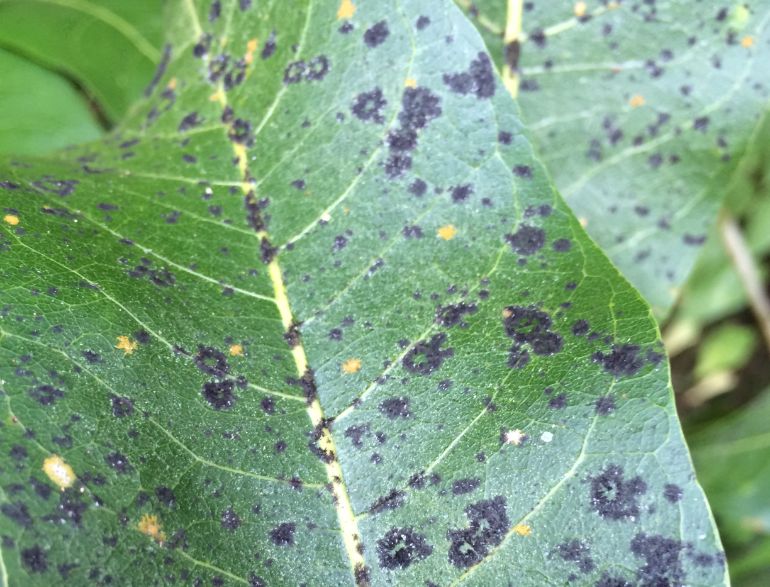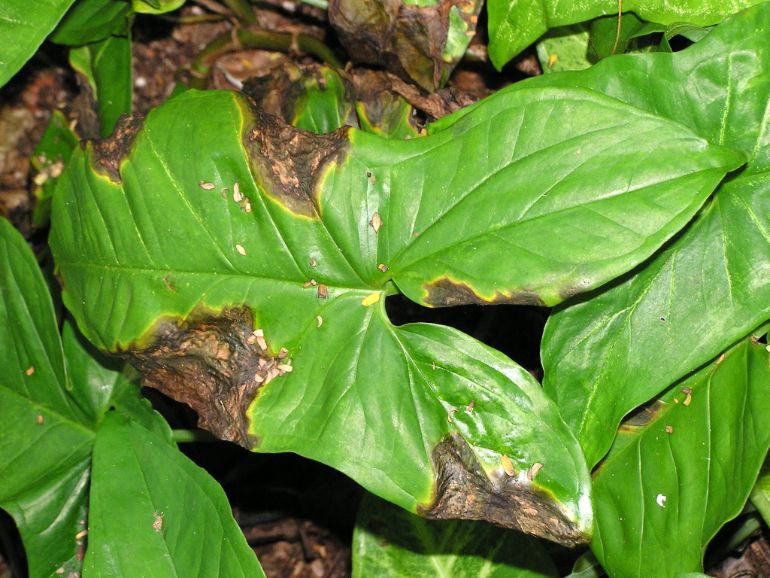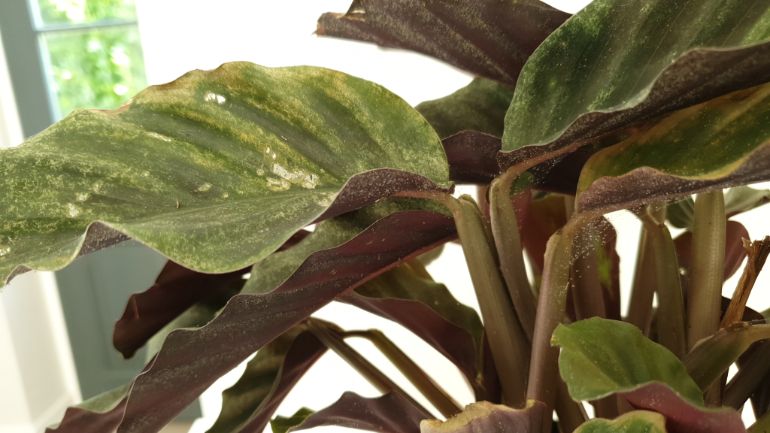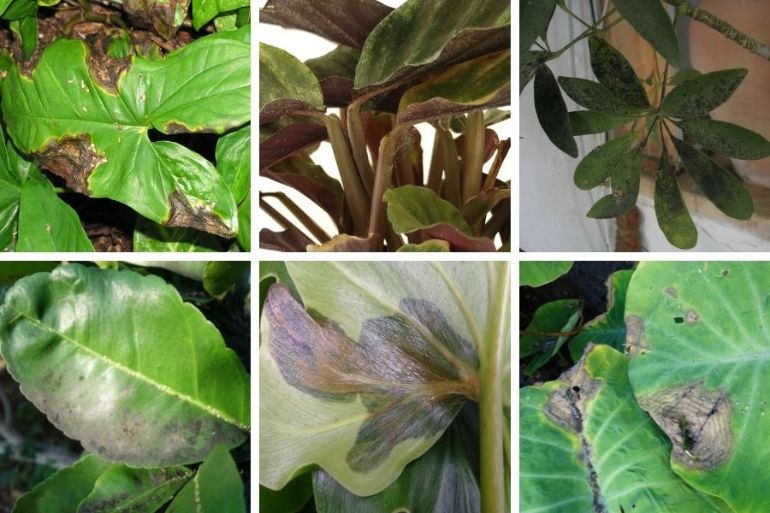Black spots are the last thing we want to see on our beautiful houseplant’s leaves. It isn’t uncommon, though some houseplants are more prone to the issue. In this article, we’ll look at what can cause black spots on houseplant leaves and the best way to get rid of them.
Black spots on houseplant leaves are frequently caused by fungal disease or pest damage. Overwatering should be ruled out, too. Less frequent causes are bacterial or viral infection, aging, or nutrient deficiency. Correct care issues, isolate and remove affected leaves before treating.
Overview Of Black Spots On Houseplant Leaves
Black spots aren’t a cause for celebration, but they don’t automatically spell encroaching doom for your plant. The affliction usually looks worse than it is: the damaged leaves often continue functioning and don’t actually die.
The unsightly spots can be of different sizes; some are round, others have irregular edges. While they are unlikely to disappear from affected foliage, new leaves will be spot-free once the cause is remedied.
Some reasons for black spots are serious, so don’t ignore the issue. Treatment varies according to its cause, so figuring out the problem is crucial.
The best way to prevent black spots is to keep the plant healthy! A robust houseplant is not only more resistant, but it will also recover and replace damaged leaves with fresh foliage more quickly.
Age Decline
Before going further, make sure the foliage isn’t simply old and worn out. Natural deterioration happens as a plant decommissions its older leaves and reroutes their life force to other parts.
Age issues usually affect bottom leaves, and natural decline won’t happen to many leaves all at once. You can slow the process by giving the plant excellent care. Cleaning the foliage and rotating the plant so all the leaves get their share of light helps ensure maximum longevity.
Rule out Overwatering!
The first thing to rule out is the most serious possibility: overwatering. This is the most common killer of houseplants – black spots may be a final cry for help.
Overwatering damage starts with the roots and spreads upward. If the leaves are being affected, your plant is in serious trouble and there’s no time for delay.
Check by carefully unpotting the plant and making sure the roots are pale, firm, and have a healthy, earthy aroma. If you find mushy black or brown roots that emit a foul smell, your plant has root rot, and you’ll need to take action.
If the rot isn’t extensive, cut away damaged roots and refresh the pot with a similar (dry) mix … let the soil dry out and water sparingly until you see new growth. Repot into more appropriate soil if drainage is an issue, and reevaluate your regimen so it doesn’t happen again.
Fungal Infection
The most common reason for dramatic black spots is a fungal infection. Not every plant is susceptible to the same fungi: such infections are generically termed “Leaf Spot.” The treatment is essentially the same regardless of the specific fungus attacking your plant.
Fungal pathogens love wet conditions and spread easily from drips or splashes – which provides the key to solving the problem. Fungal spores remain dormant until activated by water (and they can wait a long time). Fungal infection is a sign the plant is too moist or that water has lingered too long on the leaves.
Keeping the plant a bit drier and making sure the leaves don’t stay wet is the best prevention and treatment. Here are steps to take:
- Water from the base rather than the top. Nestle the hose or watering can under the bottom leaves to avoid wetting the foliage or place the pot in a shallow tray of water until the soil has soaked the moisture up from below.
- Water early in the day to provide plenty of time for the foliage to dry.
- Provide good ventilation to air the leaves out.
- Avoid misting the leaves.
Remove affected foliage to reduce further contamination; discard safely. Fungal infections aren’t usually dangerous if addressed early, and they don’t cause permanent damage once the cause is corrected.

Fungal Treatments
In addition to removing spotted foliage and keeping the leaves dry, it’s a good idea to treat the fungal infection head on. There are several approaches:
Fungicides – There are some effective fungicides on the market. Often these come in convenient spray bottles; some brands claim to be organic. Commercial fungicides are an easy way to treat a limited infection of a few houseplants, but they get expensive when used for larger outbreaks or for landscape plants.
Neem Oil – Typically used as a natural means to control pests, Neem oil is an all-natural treatment that also controls many kinds of fungus. It doesn’t kill existing fungi but instead smothers their spores so they don’t spread. It’s necessary to coat the foliage of affected plants thoroughly for maximum effect.
Neem oil is safe for the environment and most plants, but it can burn foliage that’s exposed to direct sun. Don’t use it on very young or stressed specimens.
Home Remedies – A simple and economical treatment is traditionally made by mixing a tablespoon of baking soda in a gallon of water. Add a half teaspoon of horticultural oil or insecticidal soap to make it stick to the plant.
Spraying the fungus with this concoction alters the leaf surface’s pH and creates an unlivable environment for the fungus. It costs only pennies per gallon.
Bacterial And Viral Infections Often Cause Black Spots On Houseplant Leaves
Black spots on houseplant leaves can also be a symptom of bacterial or viral disease, but the prognosis isn’t quite as cheery as for a fungal infection. Plants are affected by different infectious agents and some species are more resistant than others, but any plant in a weakened, stressed state is vulnerable.
There aren’t any effective chemical treatments for houseplants, unfortunately.
If you suspect this kind of infection, remove the leaves that show symptoms and destroy them safely to avoid further contamination.
The best tools for managing bacterial or viral disease are prevention and sanitation:
- Give the plant extra TLC to increase its ability to fight or outgrow the infection.
- Sterilize your tools before and between uses. A simple wipe with isopropyl (rubbing) alcohol will do the trick.
- Keep your plants properly distanced from each other. If you group your plants together, try to keep their foliage from touching.

Pests
Another common reason for spots on plant leaves is pest infestation. The most common offenders are aphids, spider mites, scale, and mealybugs. Thrips, gnats, and root mites are prevalent in some areas, too.
The “good” thing is that you can usually identify the culprit by the damage they cause:
- Aphids seem to come out of nowhere to cluster around tender leaves, shoots and stems. If they mass in sufficient numbers – as they greatly aspire to do – aphids cause sickly, yellowed leaves and discolored spotting. They also excrete sweet nectar that fosters black sooty mold.
- Spider mite damage looks like silver, yellow or dark pinhole-sized mottling on leaves. These unpleasant arachnids are tiny, reaching an adult size of only .016 inches (.4 mm), so a magnifying glass will help you identify them. They leave tiny webs under leaves and in the joints.
- Scale are special little nasties with a rap sheet that resembles an aphid. The holes they create are usually silvery or yellowish; their honeydew coats lower leaves and often turns black from mold. Mature scale is legless and looks like a bump on the plant.
- Mealybugs are another villain from the scale family. They add a distinctive fuzzy wrap, so that their colonies look like cottony masses around joints and underneath the foliage. As with other honeydew excreters, the leaves beneath them are often sticky and black with sooty mold.
If you’ve identified a pest problem, you should trim severely damaged leaves (and discard them safely). Many growers leave partly affected leaves and treat them along with the whole plant.
These pests respond to being hosed off to reduce their numbers and thoroughly coated with an environmentally-friendly pesticide like insecticidal soap or horticultural oil. Neem oil and diatomaceous earth (DE) are also natural and effective … rubbing alcohol works, too.
Eradication isn’t possible with just one treatment. Repeat until the pests are gone, and remember that they can come back! You can read more about identifying, treating, and preventing houseplant pests in this article.

Less Likely Causes Of Black Spots On Houseplant Leaves
There are other possibilities to consider if you’ve ruled out the common causes. These are less likely to be the culprit because their damage doesn’t usually look like black spotting.
- Nutritional Deficiency – Though it’s not common, a lack of nutrients can cause leaf streaking and/or spotting. The color of the damage is typically yellow to brown.
- Sunburn – Intense direct sunshine can scorch and damage leaves. Sunburn usually results in bleached foliage or crispy brown splotches on the leaf’s surface.
- Low Humidity – Besides slow growth and a dull appearance, low-humidity stress causes dry spots and patches on leaves.
- Cold Temperatures or Drafts – Plants stressed from cold or drafty conditions can develop spotted or otherwise marred foliage.
- Water Quality – Leaves can become unevenly discolored if your watering source is highly mineralized or your plant is sensitive to contaminants.
Related Articles
- Causes Of Brown Spots On Houseplant Leaves (Causes And Solutions)
- 10 Causes Of Yellow Leaves On Houseplants (And How To Fix Them)
- How To Identify, Fix And Prevent Houseplant Pests
- How To Identify, Fix, And Prevent Common Houseplant Diseases
- What Is The Best Type Of Water For Houseplants
- Check Out My Book, “Houseplants Made Easy”
Published on 17th May 2021

